Empty. That was how it felt. Salander had hardly slept for a week and she had probably also had too little to drink and eat, and now her head ached and her eyes were bloodshot and her hands shook and what she wanted above all was to sweep all of her equipment to the floor. — David Lagercrantz, The Girl in the Spider’s Web
 The Girl in the Spider’s Web (Millennium Trilogy #4)
The Girl in the Spider’s Web (Millennium Trilogy #4)
David Lagercrantz
![]()
I won’t read Go Set a Watchman, Harper Lee’s rejected first draft of what became To Kill a Mockingbird. Harper Lee, when she was younger and thinking clearly, intentionally hid the manuscript away. The story of its recent “discovery,” and the rush to publish it, is a story of naked greed.
Naked greed is at play here too, of course, but Stieg Larsson is dead. Legal wrangling over what manuscripts and notes may or may not remain on Larsson’s laptop aside, I did not have the same qualms about reading The Girl in the Spider’s Web. This is not Larsson’s “unfinished fourth novel,” supposing that novel even exists. It’s another story entirely. Larsson isn’t around to keep Blomqvist and Salander alive, and I don’t mind another author taking a crack at it.
Really, this is just pop fiction, and by the standards of pop fiction, Lagercrantz successfully recreates the main characters from Larsson’s previous novels. He also crafts a servicable set of villains and an appropriately elaborate plot, and in these aspects his novel is a worthy continuation of the Millennium series.
There are problems, but my affection for Mikael and Lisbeth (and many other familiar characters from the first three novels) carried me through some clumsy, wooden passages. Specifically, Lagercrantz takes shortcuts by stepping in as a once-removed omniscient narrator to fill in large sections of backstory. In several places in the novel, he’ll have Blomqvist or Salander interrogate a side character who, over the course of several pages, conveniently explains things it might have taken days or weeks to uncover, detailing how one thing led to another and bringing the reader up to the point where the next action scene can occur. These minor characters, having served their purposes in advancing the plot, never appear again.
It may have saved Lagercrantz a lot of work, explaining much of the backstory rather than letting the reader experience it through action, but those passages were a letdown in what was otherwise a pretty good and exciting story.
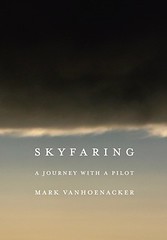 Skyfaring: A Journey with a Pilot
Skyfaring: A Journey with a Pilot
Mark Vanhoenacker
![]()
As a child, I dreamed about flying airplanes. I sought out books about flying, trying to get some insight into what it was like and what a career in aviation might entail. I read Lindbergh’s We and The Spirit of St. Louis. I built model after model. When I was older I devoured the memoirs of military pilots who flew in WWII, Korea, and Vietnam. And then I did become a pilot, embarking on a 24-year career flying trainers and fighters for the US Air Force. My dreams of late have turned to writing about flying. But are there any readers still looking for books about flying? It’s not like it’s still a new thing, after all.
Judging by the critical reaction to Mark Vanhoenacker’s memoir, yes, there are readers who dream of flying. There are a lot of them. Now the question is, can I write about flying a tenth as well as Mark Vanhoenacker?
What Skyfaring does best is to explain the psyche of a person who, like me, dreamed of flying, and having flown, discovered it more than lives up to the dream. What it does next best is to explain the arcane, often maritime, history behind the rules and language of flight, and to do it in a poetic, evocative way.
I first learned about Mark Vanhoenacker when I saw one of his articles in a magazine. It was about the five-letter names of junctions and waypoints on aeronautical charts, and it picked up on something I’d noticed myself, that the seemingly arbitrary names are anything but, often reflecting national, regional, and cultural themes. This article, I was happy to discover, forms part of a longer chapter in Skyfaring.
The kind of flying I did is quite different from the kind of flying Mark Vanhoenacker does, but he and I love many of the same things: at night, the silence and solitude, the utter blackness of oceanic crossings, the light of distant cities over land, the aurora and, occasionally, St Elmo’s fire; in daylight, the incredibly blue and clear skies above the weather, the sensation of speed you experience when you’re close to clouds, the shadow of your own airplane below you, the grand geographical features passing slowly underneath.
In Skyfaring, we see a uniformly rosy picture of flying and the career of a long-haul commercial pilot. Mark Vanhoenacker doesn’t tell war stories: there’s not a single “There I was …” moment in his memoir. I cannot believe any pilot at the mid-point of a career flying Airbus 320s and Boeing 747s doesn’t have a few hair-raising experiences to relate, and I was more than a little disappointed he didn’t share any of those experiences with us. This may be a case of self-censorship: he’s still cashing paychecks from British Airways, after all.
I loved everything else about this book. I haven’t dreamed of flying in years. Writing about flying, as I have begun to do, is quite frankly my personal attempt to bring back the sense of wonder and adventure I experienced as a child, dreaming of a career in aviation. Reading Skyfaring inspires me to try harder, to keep my own dream alive.
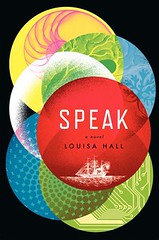 Speak
Speak
Louisa Hall
![]()
I enjoyed reading Louisa Hall’s Speak, but didn’t see some of the things other reviewers report seeing, in particular a strong resemblance to David Mitchell’s Cloud Atlas. Yes, like Cloud Atlas, Speak tells its story through diaries, letters, and court transcripts from different eras, but the people who speak through these documents aren’t spiritually connected to one another; rather, they’re tied by the subject of the novel, the beginnings of the development of artificial intelligence.
I can’t comment on Speak without revealing a few plot items, so read no further if you’re the kind of person who won’t read a book it you hear anything about it beforehand (you’re not fooling anyone; you aren’t going to read it anyway).
The AI in this novel is not the fully-human-and-then-some HAL who manages the floating cities and starships of space operas. With one exception, the AIs interacting with humans in Speak don’t seem to experience consciousness. Chatbots and “baby bots” interact with humans in seemingly thoughtful ways, but they’re really just sophisticated mimics. The exception is laid out in a few creepy chapters inside the mind of a confiscated baby bot nursing its dying batteries in an abandoned hangar filled with other contraband baby bots. The implication here is that the lifelike baby bots do in fact experience consciousness, unknown to their creators.
The novel’s premise was intriguing enough to keep me going. The individual stories that make up the whole, particularly the (wholly fictional) diary entries of a 17th century girl named Mary Bradford and Alan Turing’s (ditto) letters to a friend’s mother, written in the first half of the 20th century, are fascinating. Likewise the near-future transcripts of conversations between a chatbot and Gaby, a young girl whose “too lifelike” baby bot has been taken from her by the authorities. Less so the letters exchanged by a late 20th century husband and wife who help develop the computer-based AI program of the near future; far less so the self-pitying 2040 prison journal of the man who created the baby bots, at first to great acclaim and later to universal condemnation.
One connection I don’t see in other reviews of Speak: how Mary Bradford and her dog Ralph relate to human/AI interdependencies of the future. Mary regards her dog as a person, to such an extent that she is spiritually crippled when Ralph is lost. Her parents and husband see this clearly, and unsuccessfully try to convince her Ralph lacked a soul. Mary is the Gaby of the 2030s, literally paralyzed after her closest companion, a baby bot, is taken from her.
Thoughtful, intriguing, well written.
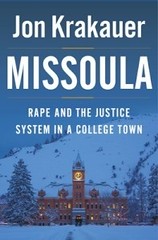 Missoula: Rape and the Justice System in a College Town
Missoula: Rape and the Justice System in a College Town
Jon Krakauer
![]()
I bogged down and began to lose interest very early on, which surprised me. The subject matter—the date rape of several college coeds by big man on campus-type football players—should be compelling. Moreover, the author, up to now, has been a compelling writer, able to turn almost anything into gold. I think the flaw in Missoula is Krakauer’s exhaustive recounting of legal detail: repetitive and dry accounts of proceedings and procedures followed by off-campus law enforcement, campus administration, and civil courts in dealing with the various rapes and rape allegations at the heart of the story.
The part of the story that begs for more attention—and doesn’t really get it—is the power and influence of college athletic programs, their pervasive influence on the community and press, their mover & shaker big-money supporters, their near-100% effectiveness in shielding high-value football players from legal consequences, no matter how outrageous their behavior or criminality.
Krakauer takes the side of the women who were raped and argues passionately on their behalf. One of the rapes at the center of the story is out-and-out rape, and no one could disagree with that. But other rapes (while still rapes) are more complex: one woman flirts with her eventual rapist earlier in the evening and invites him to her dorm room with an explicit promise of sexual intercourse, only to tell him to stop once he’s in her room. Another woman invites a BMOC football player to her room, takes off her shirt and bra, and gets in bed with him—only to say later that she didn’t intend it as an invitation to sex. Then, after he forces himself on her, she drives him home.
Alcohol is the common denominator to every rape case Krakauer recounts. All the women were drunk. All the men were drunk. It’s an ugly truth about campus life Krakauer doesn’t confront head on, just as he acknowledges, but does not attack, the entrenched, NRA-like power and influence of college athletic programs.
It’s an aggravating book, tedious to read, and left me wondering why we don’t take another stab at prohibition. And outlaw college athletics while we’re at it.
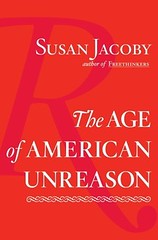 The Age of American Unreason
The Age of American Unreason
Susan Jacoby
![]()
Broader in scope than Al Gore’s The Assault on Reason (2007), The Age of American Unreason (2008) attempts to trace the history of highbrow, middlebrow, and lowbrow culture and thinking in America, comparing past ages to the present age, digging particularly into the influence various factors—religion, popular culture, consumerism, the press and electronic media—have on the quality of public discourse and what passes for reason in America.
After the first chapter, I began to feel I was locked in a room with an embittered Kennedy liberal going on and on about how everything’s gone to hell since the days of Camelot. I wanted to argue with Susan Jacoby, and sometimes I did, even to the point of talking out loud to the book in my hands. And perhaps that was her intention, to engage the reader. If so, consider that praise. But otherwise? Beethoven is superior to the Beatles? Pulp fiction doesn’t compare to the classics? TV is junk? Do tell.
Jacoby has done her research. Her chapters on the history of popular culture, literature and magazines, and music were, to me, the most entertaining. Since I know something of the thinkers, writers, and musicians she wrote about, I can appreciate her scholarship, and I’ll assume she applied just as much discipline and rigor to subjects I know less about.
Still, I think she’s flat out wrong on certain things: e-books and e-reading, for example, which she characterizes as a cultural and commercial failure. This contradicts what I observe with my own eyes: e-books and e-reading are enormously popular, not just for entertainment reading but serious study as well—has she seen how many college students buy e-texts for their courses? Has she tracked how many people are reading her own book on a Kindle or Nook?
Her biggest feat of wrongness, IMO, is in thinking there was ever a more enlightened era in American history. My own study of history leads me to believe the ratio of dumbness to intelligence has always been about the same. The kids aren’t any worse than they ever were. Joe Sixpack has always been with us. The country’s always been going to hell in a hand basket.
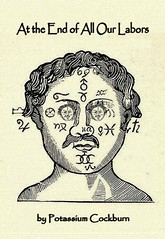 At the End of All Our Labors
At the End of All Our Labors
Potassium Cockburn
![]()
Full disclosure: Mr Cockburn—if indeed that is his real name—asked me to read and review his novel, and I agreed.
I thought the opening chapters of At the End of All Our Labors were strong, promising a good science fiction novel on the subject of crossing over into an alternate universe. The protagonist, a doctor, is being interrogated about his participation in a secretive project. All that remains of the underground research facility where he and hundreds of others worked is a crater, and he appears to be the sole survivor. His interrogators are anxious to find out what had been going on there before the explosion. A few hints had me thinking the doctor was now in an alternate universe, because when he discusses recent history with his interrogator, his history and that of the interrogator do not match up. An intriguing start.
We jump from the interrogation cell back into the underground research facility with the doctor and several others who have been recruited for the project. Yes, necessary backstory! I kept reading. It soon transpires, however, that no one—not the doctor, not any of the other people in the facility with him—is what he or she seems to be, and no one can be trusted. In fact the entire project might be a fiction, a play within a play, the doctor playing a unwitting role in something he didn’t sign up for.
The doctor is no rebel. He willingly agrees to all manner of confidentiality agreements, including one that allows his new employer to alter his brain so that he is physically and psychologically unable to divulge industrial secrets. He goes along to get along, and yet soon finds himself working with a secretive cabal within the project to sabotage the entire operation—and possibly catapult him and everyone else into an alternate universe. As backstory, this fits perfectly with the opening.
Then, in the last third of the book, Mr Cockburn begins to layer realities, on atop another, to the point where the reader needs a notebook to tell him what layer he’s in. Previous stories are revealed to be false memories implanted in the doctor’s brain—or are they? In any event, a new reality has replaced the previous one, but it will soon be revealed to have been another false memory, and oh wait, here comes another reality, and so on. I didn’t have a notebook, and was thus unable to keep track of final chapters’ twists and turns.
I won’t say Mr. Cockburn ends his novel with the proverbial “it was just a dream” trope, but he comes pretty close.
Overall, I was disappointed to see what promised to be a gripping and interesting science fiction story become an exercise in conflicting perceptions of reality.
A better continuation of a character associated with a dead but highly praised author is Benjamin Black’s Black Eyed Blond continuing Phillip Marlowe and even Robert Parker’s Perchance to Dream a continuation of Marlowe from the Big Sleep. Does Lisbeth spend as much time and money at Ikea in this one.